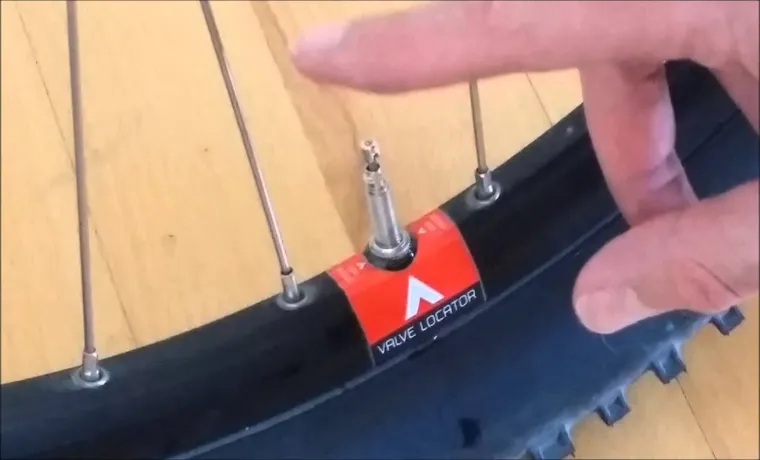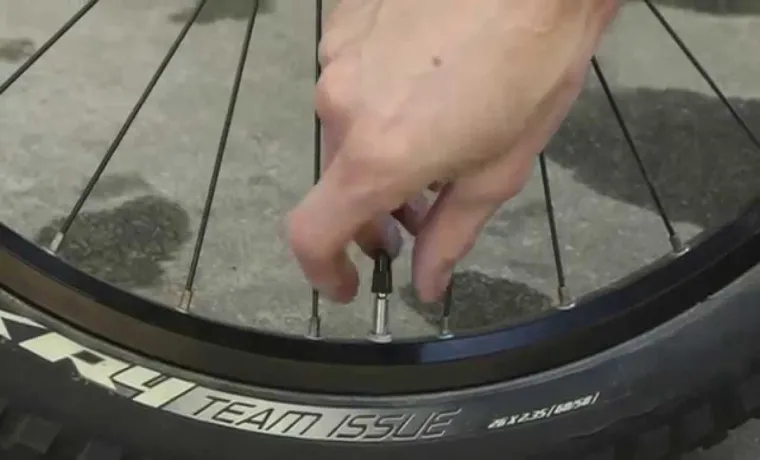Have you ever hopped on your bike to take a ride and noticed that your tires were a bit flat? Don’t let that stop you from hitting the road! Inflating your bike tires is a quick and easy task, and with a bit of knowledge, you’ll be back on the road in no time. If you have a Presta valve on your bike, you might be wondering how to inflate your tires properly. Don’t worry; we’ve got you covered! In this blog post, we’ll go over everything you need to know about inflating bike tires with a Presta valve, from the tools you’ll need to the step-by-step process.
So, grab your bike pump and let’s get started!
Table of Contents
- 1 Understanding Presta Valves
- 2 Materials Needed for Inflating a Bike Tire with a Presta Valve
- 3 Steps to Inflate a Bike Tire with a Presta Valve
- 3.1 Step 1: Unscrew the Presta Valve Cap
- 3.2 Step 2: Check the Current Tire Pressure
- 3.3 Step 3: Screw the Pump Head onto the Valve Stem
- 3.4 Step 4: Begin Pumping Air into the Tire
- 3.5 Step 5: Monitor the Tire Pressure
- 3.6 Step 6: Remove the Pump Head from the Valve Stem
- 3.7 Step 7: Screw the Presta Valve Cap Back On
- 4 Conclusion
- 5 FAQs
Understanding Presta Valves
If you’re new to cycling, you might find yourself struggling to inflate your tires with a Presta valve. Unlike Schrader valves that are commonly seen on cars and some bikes, Presta valves have a narrower stem and require a bit of extra care and attention. To inflate your bike tire with a Presta valve, first unscrew the valve cap and press down on the valve stem to release a small amount of air.
Next, attach your pump to the valve by loosening the locking nut and placing the pump nozzle over the valve. Make sure the pump is securely in place before tightening the locking nut. Finally, pump the tire to your desired pressure and remove the pump by loosening the locking nut and lifting it off the valve.
Don’t forget to replace the valve cap to protect the valve from dirt and debris. With a bit of practice, inflating a bike tire with a Presta valve will become second nature.
What Are Presta Valves?
Presta valves are a type of valve commonly found on high-performance bicycles. They have a slender and elongated shape compared to the more common Schrader valves found on most bikes. Presta valves feature a threaded shaft that can be opened and closed, allowing air to enter or exit the tire.
They require a separate pump head to be used, which can be bothersome for some cyclists. However, Presta valves are a great option for those looking for a valve that can better handle high pressures commonly found in road biking tires. In terms of maintenance and upkeep, Presta valves must be checked for proper inflation regularly and should be carefully tightened to avoid damaging the valve stem or tire.
Overall, Presta valves are a reliable and efficient option for serious cyclists looking for better performance out of their bike tires.

Advantages of Presta Valves
Presta valves are commonly used in high-performance bicycles due to their lightweight construction and unique design. Unlike Schrader valves that are commonly found in cars and other vehicles, Presta valves feature a thin metal stem that requires a narrower opening on the rim of the wheel. The advantages of Presta valves over Schrader valves include a larger air passage for faster airflow and better air pressure monitoring due to its tighter seal.
Additionally, Presta valves are easier to use with tire sealant, making them a popular choice for tubeless setups. However, a disadvantage of Presta valves is that they can be more prone to air leakage due to its threaded locking system, making it essential to ensure proper locking and tightening of the valve cap. Understanding Presta valves is crucial for anyone looking to enhance their cycling experience, and with proper maintenance and care, they can provide a reliable and efficient means of inflating tires for years to come.
Identifying the Presta Valve on Your Bike Tire
If you’re an avid cyclist, you’re probably familiar with Presta valves. These valves are commonly found on higher-end bikes and are known for their effectiveness in high-pressure situations. The Presta valve is typically identified by its long, thin body and threaded top.
To inflate your tire with a Presta valve, you’ll need a special pump with a narrow head that can fit into the valve’s small opening. To check if your tire has a Presta valve, simply look for the valve stem on the inner tube. If the valve looks like a miniature version of a water faucet, it’s a Presta valve.
By understanding Presta valves, you’ll be able to easily identify them on your own bike and properly inflate your tires for a smoother ride.
Materials Needed for Inflating a Bike Tire with a Presta Valve
Inflating a bike tire with a Presta valve may seem a bit daunting for those who are used to the more common Schrader valves. But fear not, the process is quite simple once you have the right materials. To inflate a bike tire with a Presta valve, you’ll need a pump with a Presta valve head or an adapter to convert your pump to a Presta valve head.
Once you have the correct pump, you can insert the valve head into the valve and thread the pump onto the valve stem. Make sure the pump is securely connected and start pumping. Be careful not to over-inflate the tire as Presta valves have a higher pressure rating than Schrader valves.
Check the manufacturer’s recommended pressure range and use a pressure gauge to ensure you end up with the right pressure. With a little practice, inflating a bike tire with a Presta valve is a breeze.
Air Pump with Presta Valve Adapter
If you’re looking to pump up your bike tires with a presta valve, you’ll need a few materials to make it happen. First and foremost, you’ll need an air pump. A good one will give you the power and control to inflate your tires to the right pressure quickly and easily.
There are a lot of options out there, but you’ll want to look for one that’s compatible with both types of valve stems (presta and schrader) and has a pressure gauge to keep an eye on how much air you’re adding. Once you have your pump, you’ll need a presta valve adapter. This is a small, usually metal, fitting that screws onto the end of the presta valve.
It essentially converts the valve to a schrader-type, which allows you to attach the pump and start inflating the tire. The adapter is small enough to fit in your pocket or bike bag, so you can bring it with you on rides. In addition to the pump and adapter, it’s always a good idea to have a tire pressure gauge on hand.
This will allow you to verify that you’ve inflated your tire to the right pressure and avoid over- or under-inflating it. A floor pump with a built-in gauge is an excellent investment for any cyclist, but a handheld gauge will do the trick if you’re on the go. Finally, don’t forget the importance of proper inflation for your tires.
The right pressure will depend on the type of bike and riding you’re doing, so be sure to check your bike owner’s manual or ask a knowledgeable bike shop employee for recommendations. Improper inflation can affect your ride quality, handling, and safety, so it’s worth taking the time to get it right.
Pressure Gauge
If you’ve ever needed to inflate a bike tire with a Presta valve, you know how important it is to have the right materials. First and foremost, you’ll need a pressure gauge to ensure that you inflate your tire to the correct pressure. This is crucial for both your bike’s performance and your safety while riding.
Additionally, you’ll need a pump specifically designed for Presta valves. These pumps have a smaller opening and a different threading than pumps for Schrader valves, so be sure to check that yours is compatible before trying to inflate your tire. It’s also a good idea to have a valve adapter on hand, just in case you come across a Presta valve that doesn’t fit your pump.
With these materials in hand, you’ll be able to confidently inflate your Presta valve bike tire and hit the road with ease.
Steps to Inflate a Bike Tire with a Presta Valve
If you’re a cyclist, you know that inflating the tires is a fundamental aspect of maintaining your bike’s performance. However, Presta valves can be a bit confusing for those who are new to cycling. To inflate a bike tire with a Presta valve, start by unscrewing the valve cap.
Next, attach the pump to the valve and ensure that it is secure. Presta valves have a locking mechanism that must be manually released before inflating. To do this, turn the valve cap anti-clockwise, and the valve will pop up.
You can now inflate the tire with the appropriate amount of pressure. Make sure to check the recommended pressure range and adjust accordingly. Finally, release the pump from the valve, and screw the valve cap back onto the valve.
Following these steps will ensure a proper and safe inflation process for your bike tire with a Presta valve. Happy cycling!
Step 1: Unscrew the Presta Valve Cap
If you have a bike with a Presta valve, learning how to inflate your tires can seem like a daunting task. However, the process is actually quite simple! The first step is to unscrew the Presta valve cap. This little cap protects the valve and keeps dirt and debris from getting inside.
Set the cap aside in a safe place where you won’t lose it. Once the cap is off, you’ll be able to see the valve itself. It’s a small, narrow piece of metal in the center of the valve stem.
Presta valves require a special pump head that fits snugly onto the valve and creates a seal. This is called a Presta valve adapter. With the valve adapter in place, you can begin inflating your tire to the recommended pressure.
Remember to keep an eye on the pressure gauge as you pump, and stop once you’ve hit the desired level. Then, remove the valve adapter, screw the Presta valve cap back on, and you’re ready to hit the road! With a bit of practice, inflating your bike tire with a Presta valve will become second nature, and you’ll be riding confidently in no time.
Step 2: Check the Current Tire Pressure
Before starting, it’s essential to check the current tire pressure of your bike tire with a Presta valve. You can do this by using a tire pressure gauge that can be easily purchased from any bike store. The recommended tire pressure is usually written on the sidewall of the tire, but it’s always better to confirm it with the manufacturer’s manual.
Maintaining the correct tire pressure is crucial for optimal performance, grip, and durability. Low tire pressure can result in sluggish handling, while over-inflated tires can lead to a bumpy ride and even a blowout. So, take a few minutes to check the current tire pressure and inflate accordingly.
Remember, a fully inflated tire can make all the difference in your cycling experience.
Step 3: Screw the Pump Head onto the Valve Stem
Once you have unscrewed the valve cap on a Presta valve, the next step to inflate your bike tire is to screw on the pump head. Make sure the pump head is in the “unlocked” position before attempting to attach it to the valve stem. Next, place the pump head onto the valve stem and press the lever down to lock it in place.
You should feel a secure connection between the pump head and valve stem. Once the pump head is attached, start pumping air into the tire. You may need to adjust the pump head if air is leaking out or there is resistance.
Keep pumping until your bike tire reaches the desired pressure level. Finally, unscrew the pump head and replace the valve cap to prevent any air from escaping. With these simple steps, you can easily inflate your bike tire with a Presta valve.
Step 4: Begin Pumping Air into the Tire
Inflating a bike tire with a Presta valve isn’t as hard as it may seem. Once you’ve removed the valve cover and screwed the valve cap open, you’re ready to begin pumping air into the tire. Before you start, make sure you’ve got the correct type of pump for Presta valves – one with a small nozzle to fit into the valve’s narrow opening.
Once you’ve connected your pump, hold it steady with one hand on the valve while using your other hand to begin pumping. If you’re using a floor pump, use your foot to hold it down to prevent slipping. Keep an eye on the tire’s pressure gauge as you pump – aim for the correct psi as recommended on your tire’s sidewall to ensure the optimal balance between comfort and speed.
Once you reach the appropriate pressure, remove the pump nozzle from the valve and reattach the valve cap. With these basic steps, you’ll be able to inflate your Presta valve bike tire with ease – giving you a smoother ride and a safer journey on the road.
Step 5: Monitor the Tire Pressure
If you’re inflating a bike tire with a Presta valve, it’s important to monitor the tire pressure throughout the process. After you’ve screwed the pump onto the valve and started inflating the tire, pause every few seconds to check the pressure using a bike pump gauge or a separate tire pressure gauge. This will ensure that you don’t overinflate the tire, which could cause it to burst, or underinflate it, which can make it harder to ride and increase the risk of a puncture.
Keep in mind that different types of tires require different levels of inflation, so be sure to consult the manufacturer’s guidelines or ask a bike expert if you’re not sure how much pressure to aim for. By monitoring the tire pressure closely, you’ll be able to adjust your pumping speed and know exactly when the tire is inflated to the right level for optimal performance.
Step 6: Remove the Pump Head from the Valve Stem
Once you’ve attached the pump to your Presta valve and pumped it up, it’s time to remove the pump head from the valve stem. But be careful not to release any air as you do this. To remove the pump head, simply loosen the locking lever or unscrew the valve head counterclockwise.
When you hear a small “pfft” sound, this means the pump head has been successfully detached from the valve stem. Make sure to screw the valve head tightly back in place after you’re done inflating the tire to prevent air leakage. The key to inflating a bike tire with a Presta valve is to be patient, and take it step by step.
Don’t panic if you hear a hissing sound, as this is usually just air escaping due to a loose connection. With a little practice, you’ll be able to inflate your bike tires quickly and easily, and be up and riding in no time!
Step 7: Screw the Presta Valve Cap Back On
After inflating your bike tire with the Presta valve, it’s important to screw the valve cap back on. This small cap is often overlooked, but it plays an important role in protecting the valve from dust, dirt, and moisture. Besides, if your valve cap falls off during a ride, it can cause your tire to deflate and leave you stranded on the road.
To screw the Presta valve cap back on, simply thread it clockwise onto the valve until it’s snug. You don’t need to tighten it too much, just enough to keep it from falling off. If you have a plastic cap, be careful not to strip the threads by overtightening.
On the other hand, if you have a metal cap, you can snug it down a bit more. Either way, make sure the cap is secure before you hit the road. By following these simple steps, you can keep your bike tire inflated and prolong its lifespan.
Conclusion
In conclusion, inflating a bike tire with a presta valve may seem daunting at first, but with a little know-how and the right tools, it’s as easy as riding a bike (pun intended). Remember to unscrew the valve cap, attach the pump head securely, and inflate the tire to the recommended pressure. And if you’re still struggling, just remember: when in doubt, pump it out!”
FAQs
What is a Presta valve and how does it differ from a Schrader valve?
A Presta valve is a type of valve commonly found on high-performance bicycles. Unlike a Schrader valve, it has a smaller diameter and requires a special adapter to inflate.
What tools do I need to inflate a bike tire with a Presta valve?
You will need a Presta valve adapter, a high-pressure floor pump or mini pump, and possibly a pressure gauge to ensure proper inflation.
How do I connect the Presta valve adapter to my bike tire?
Unscrew the nut at the top of the Presta valve and press down on the valve to release any trapped air. Then screw on the Presta valve adapter to the valve and tighten the nut.
How much air pressure should I put in my bike tire with a Presta valve?
The recommended tire pressure will be printed on the sidewall of your tire. Use a pressure gauge to ensure that you inflate your tire to the correct pressure.
Can I use a regular air pump at a gas station to inflate my bike tire with a Presta valve?
No, you will need a Presta valve adapter to use with the air pump at a gas station.
My Presta valve won’t hold air even though I have inflated it – what could be wrong?
Check the valve for debris or damage, and ensure that the nut at the top of the valve is tightened securely. If the valve continues to leak, it may need to be replaced.
Can I use a CO2 tire inflator to inflate my bike tire with a Presta valve?
Yes, as long as the inflator is compatible with Presta valves and you have a Presta valve adapter. Make sure to follow the instructions carefully to avoid overinflation or other damage.



